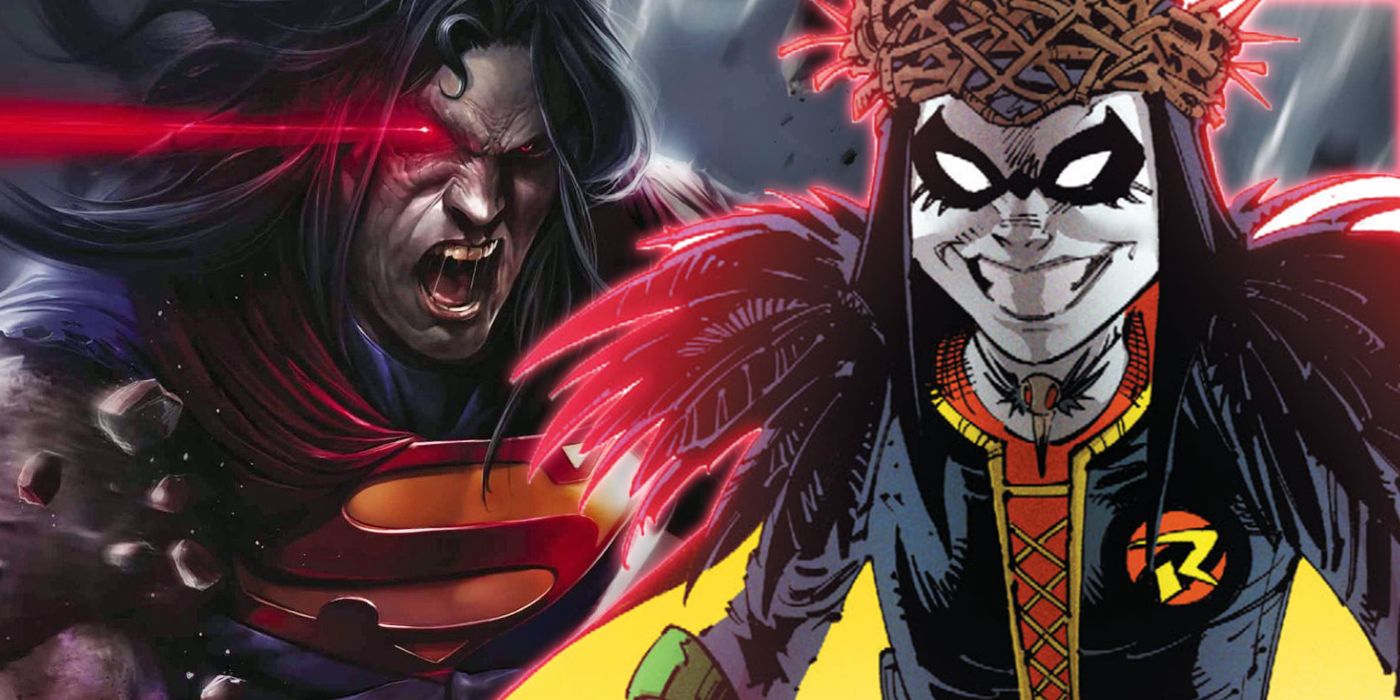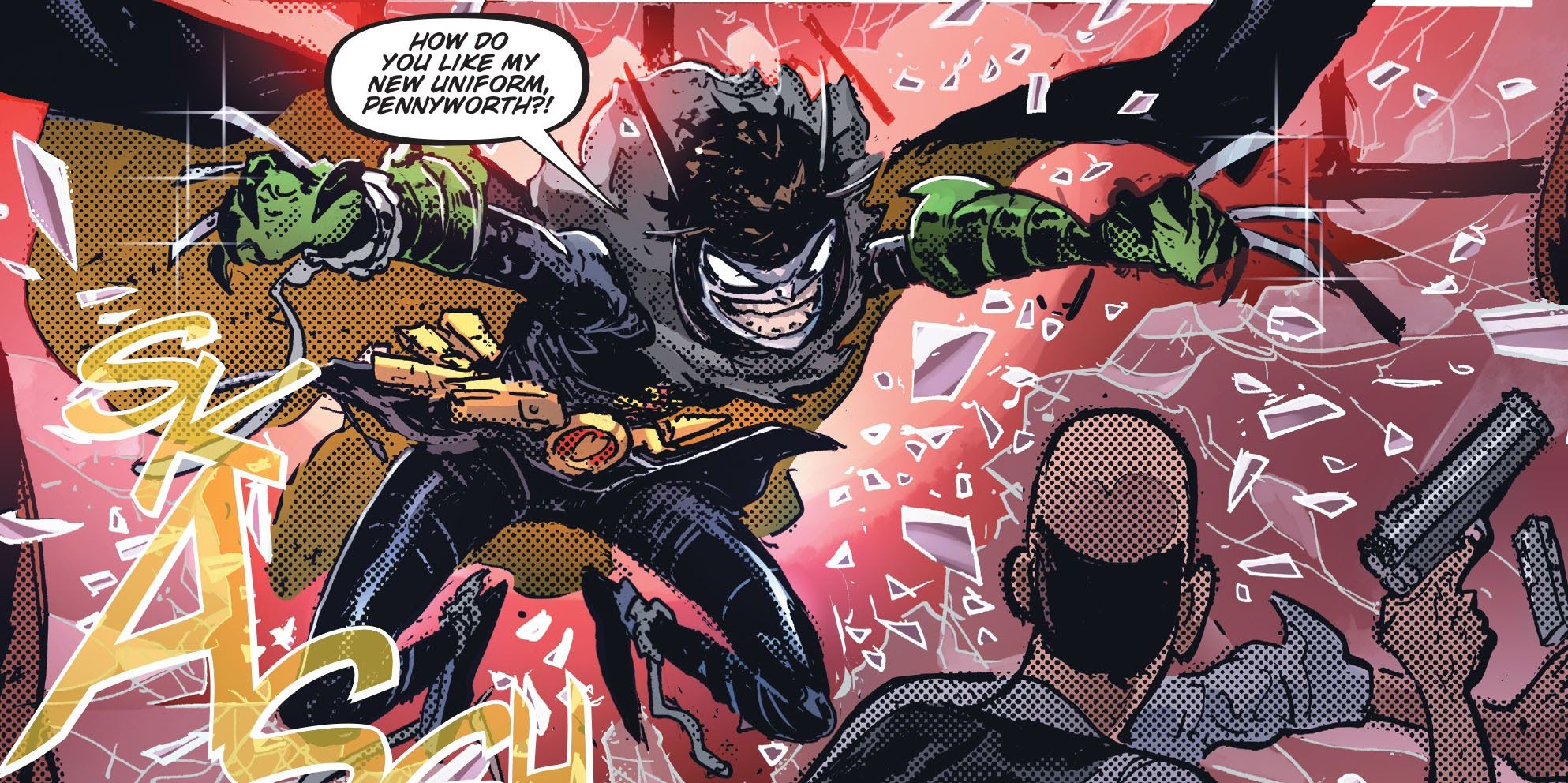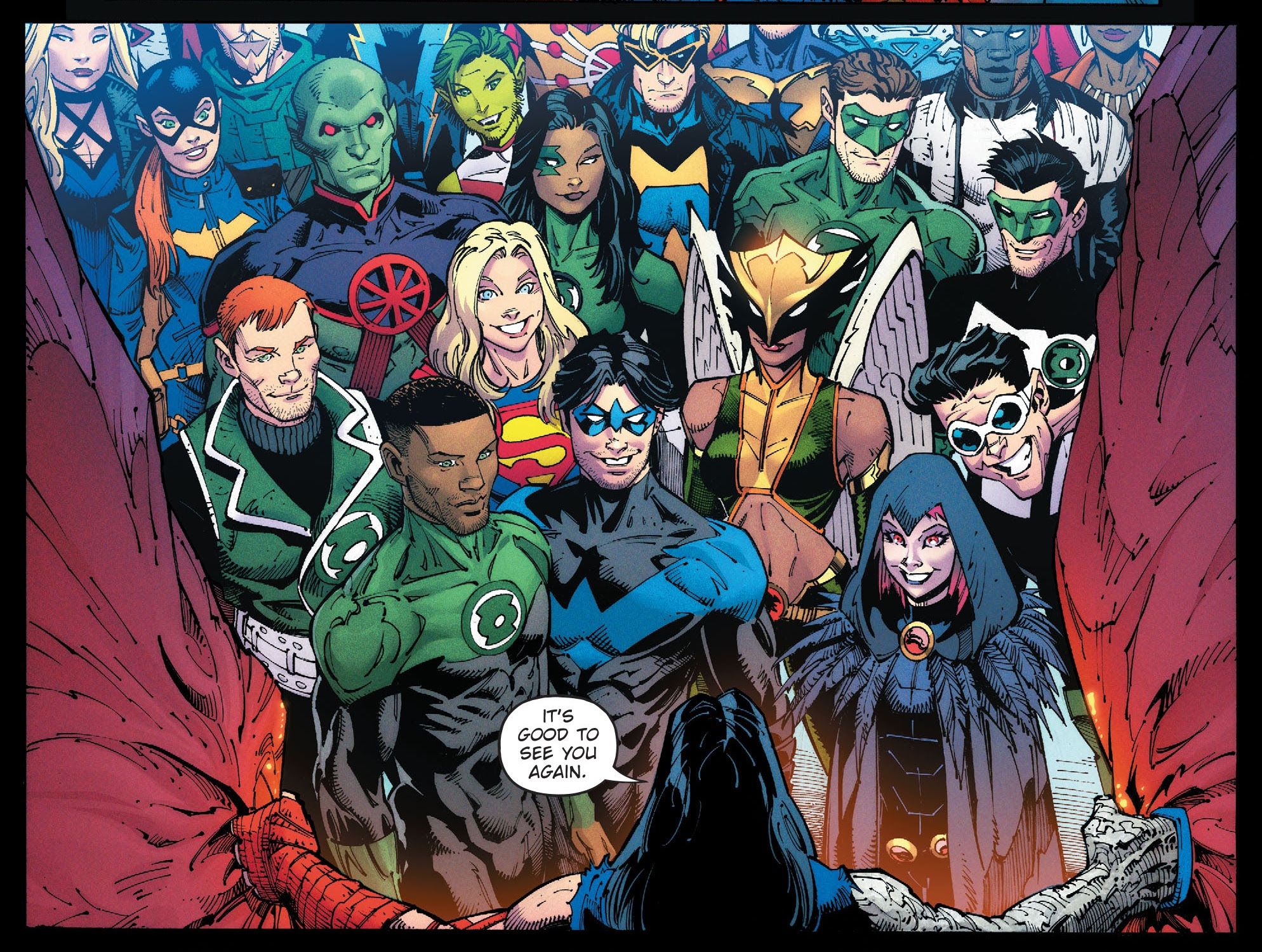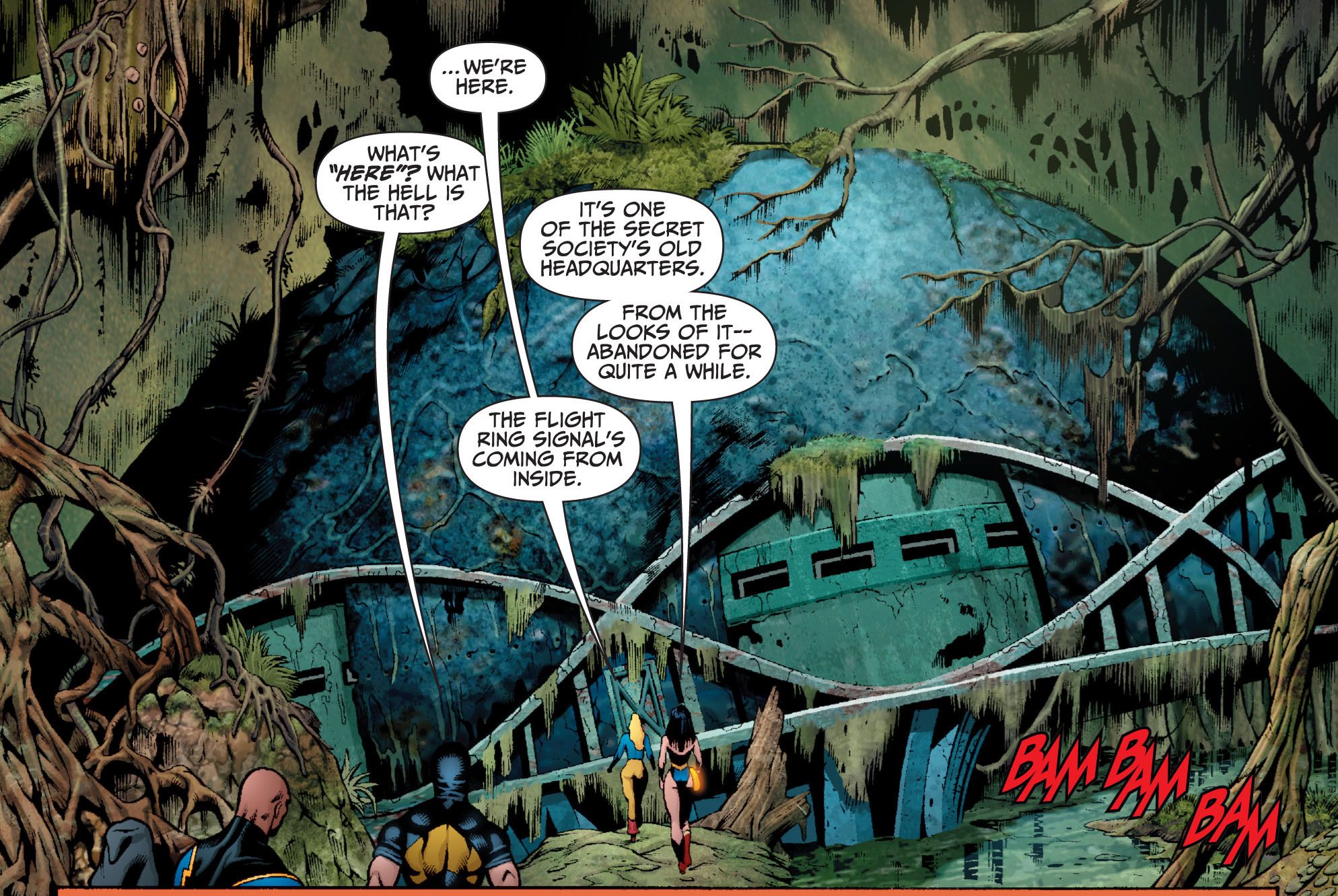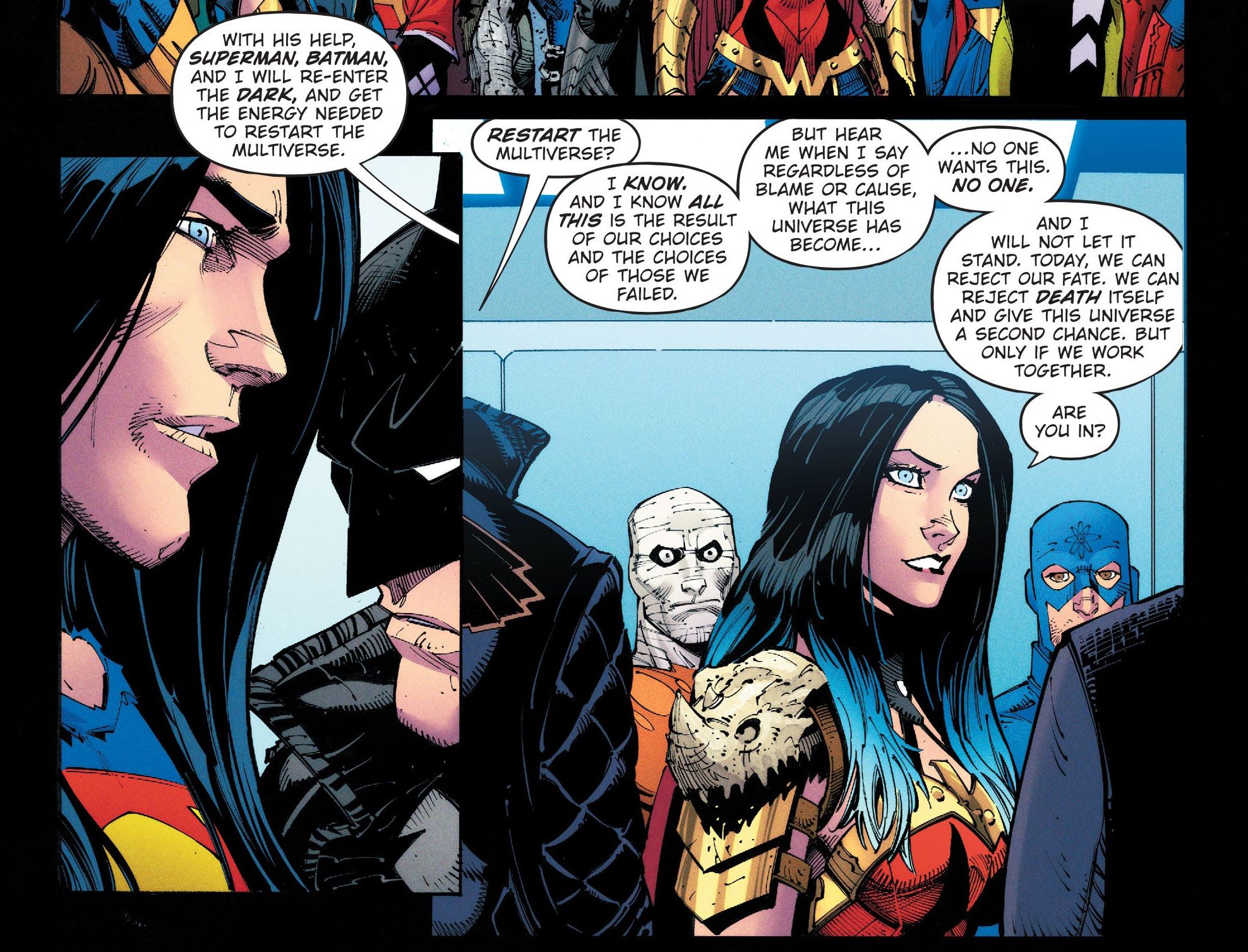WARNING: The following contains spoilers for Dark Nights: Death Metal #3 by Scott Snyder, Greg Capullo, Jonathan Glapion, FCO Plascencia and Tom Napolitano, available now.
For those about to rock, Dark Nights: Death Metal salutes you! Issue #3 is wrapping up the preliminaries and getting ready for what looks to be an awesome main event, filled with action, suspense and as usual, many nods to DC's voluminous superhero history. We can't say much more because of SPOILERS, so make sure you've got your copy of the issue handy and get ready to follow along!
Dark Nights: Death Metal #3 was written by Scott Snyder, pencilled by Greg Capullo, inked by Jonathan Glapion, colored by FCO Plascencia, and lettered by Tom Napolitano. Jared Blando is credited as cartographer, while Darran Robinson designed the publication. The associate editor was Andrew Marino and the issue was edited by Marie Javins.
Dynamic Duplexes (Pages 1-2, 6, 9, 13-14)
Right off the bat, we're very impressed with Page 1's Night Glider, who is clearly a Batman-Silver Surfer mashup. He's covered in metal, which makes perfect sense for this particular event, too. We assume that he is not to be confused with Nightrunner, a French version of Batman who was part of Batman Incorporated. (David Hine and Agustin Padilla created Nightrunner for February 2011's Detective Comics Annual #12.) And of course, Jack Kirby created the Silver Surfer for March 1966's Fantastic Four #48.
The Surfer is no stranger to the DC Universe, having appeared in October 1995's Darkseid/Galactus: The Hunger, February 1996's Green Lantern/Silver Surfer: Unholy Alliances, and November 1996's Silver Surfer/Superman. Nevertheless, we feel compelled to point out that Night Glider could also easily be a lawsuit-avoiding mashup with the Scarlet Skier, herald of Mr. Nebula and sometimes ally of Justice League Antarctica. Created by Keith Giffen, J.M. DeMatteis and Tom Artis for March 1990's Justice League America #36, the Skier was a much more thoughtful parody than his boss was.
Batrocitus (Page 1) is based on Atrocitus, who is arguably the most prominent Red Lantern. Created by Geoff Johns and Ethan Van Sciver, Atrocitus first appeared in a cameo in January 2008's Green Lantern #25, and in full in April 2008's issue #28. The Collector (also Page 1) is a Brainiac mashup with a 13th-level intelligence, so that's one better than the original or Brainiac 5. We're a little disappointed that he's not called "Batrainiac," but then again we don't have a 13th-level intelligence. Otto Binder and Curt Swan created Brainiac for July 1958's Action Comics #242.
Page 2's ParaRobins are cosplaying Parademons, Apokoliptian cannon fodder that Kirby created for March 1971's New Gods #1. In a happy coincidence, normally they wear green and yellow gear; or if you're watching an old Super Powers cartoon, red and yellow. As if you didn't know, the "Holy [Fill In The Blank]!" is an homage to Robin's flexible catchphrase on the 1966-69 Batman TV show.
We learned the hyperviolent bad-seed origin of the Robin King (Page 13) in the Dark Nights: Death Metal Legends Of The Dark Knights special. The Robin King is an adolescent Bruce Wayne who was so consumed by evil that he killed his own parents in Crime Alley and then went home to kill Alfred. That makes the Robin King a pretty deep cut (no pun intended) into Bat-history. December 1955's Detective Comics #226 revealed that not long after a young Bruce Wayne decided to become a crimefighter, he decided that private detective Harvey Harris would be his mentor. (The story was written by Edmond Hamilton and drawn by Dick Sprang.) However, to conceal his identity, Bruce came up with a very familiar red, yellow and green costume. The only thing missing was the vest's "R" insignia. The disguised Bruce did help Harris solve a case before Harris convinced him to put away the costume for good. (And no, Alfred wasn't in the picture at this time.) Therefore, Bruce Wayne as proto-Robin goes back some 65 years, and was part of mainline Bat-continuity until Crisis on Infinite Earths and "Batman: Year One" rewrote it in 1986. Indeed, Wendy – of Super Friends' Wendy and Marvin – was revealed (in the 1970s SF tie-in comic) to be Harvey's niece.
On Page 14, we see that the Robin King has, like the mainline Batman, figured out ironically appropriate ways to kill all the superheroes. (This informed the plot of "Tower of Babel," a July-October 2000 JLA storyline from issues #43-46, written by Mark Waid and penciled by Howard Porter and Steve Scott.) Here he's combined the murder of Nora Allen (part of Barry Allen's revised origin since the 2009-2010 Flash Rebirth miniseries); and the "Flash ring" (a reference to the costume being super-compressed so it's small enough for a ring-mounted compartment). The Flash ring first appeared in Barry's debut, September-October 1956's Showcase #4.
After he only appeared briefly in issue #1, this issue features Darkfather prominently. According to Page 2, he's "a Batman who took on the powers of Darkseid"; so not actually Darkseid in a Bat-costume or (as we theorized) Kalibak in a Bat-costume. We see him more clearly on Pages 6 and 9. Since Page 9 also gives us a good look at Darkfather's costume, we'll note the size of his codpiece (which we'll come back to in a minute) and that the blue shade of this costume seems very similar to the blue of the Bronze Age Batman's cape and cowl. That's ironic, considering that the Bronze Age gave way to a much gloomier, darker Batman who eventually wore all black.
As for the codpiece, longtime Bat-fans probably remember the controversy over the Batsuits in director Joel Schumacher's two Batman movies. Both 1995's Batman Forever and 1997's Batman and Robin became notorious for, among other things, highlighting the heroes' crotches in their suiting-up sequences. Accordingly, we're supposing that the Darkfather's armored area may be an homage, however indirect, to the late director's style.
The Gang's All Here (Pages 17-20)
Pages 17-19 reveal the superheroes trapped in the New Apokoliptian prison. They look to be in surprisingly good shape (and good spirits), all things considered. Here's a quick and dirty rundown of who's who, and their creative roots.
- Animal Man: Dave Wood and Carmine Infantino, for September 1965's Strange Adventures #180;
- Batgirl (wearing her "Burnside" uniform instead of the most recent version): Gardner Fox and Carmine Infantino, for January 1967's Detective Comics #359;
- Beast Boy: Arnold Drake and Bob Brown, for November 1965's Doom Patrol #99;
- Black Canary: Bob Kanigher and Carmine Infantino, August 1947's Flash Comics #86;
- Black Lightning: Tony Isabella and Trevor Von Eeden, April 1977's Black Lightning #1;
- Blue Beetle (Ted Kord): Steve Ditko and Gary Friedrich, for November 1966's Captain Atom #83;
- Booster Gold: Dan Jurgens, for February 1986's Booster Gold #1;
- Donna Troy: Arnold Drake and Bruno Premiani, for June-July 1965's Brave and the Bold #60;
- Firestorm: Gerry Conway and Al Milgrom, March 1978's Firestorm #1;
- Green Arrow: Mort Weisinger and George Papp, November 1941's More Fun Comics #73;
- Green Lanterns Hal Jordan and Guy Gardner: John Broome and Gil Kane, for September-October 1959's Showcase #22 and March 1968's Green Lantern #59, respectively.
- Green Lantern Jessica Cruz: Geoff Johns, Ivan Reis, and Doug Mahnke, for July 2013's Green Lantern #20 (cameo), June 2014's Reis-pencilled Justice League #30, August 2014's Mahnke-pencilled JL #31 (as Power Ring), and June 2016's JL #50 (as a Green Lantern);
- Green Lantern John Stewart: Denny O'Neil and Neal Adams, for December-January 1971-72's Green Lantern #87;
- Green Lantern Kyle Rayner: Ron Marz and Darryl Banks, for January 1994's Green Lantern #48 (he got his power ring in March 1994's GL #50);
- Hawkgirl (Kendra Saunders): David Goyer and James Robinson, for August 1999's JSA Secret Files #1, in a story penciled by Scott Benefiel and inked by Mark Propst (based on the original creation of Gardner Fox and Dennis Neville who first appeared in January 1940's Flash Comics #1);
- Ice: Keith Giffen, J.M. DeMatteis and Kevin Maguire, for April 1988's Justice League International #12;
- Martian Manhunter: Joe Certa and Joe Samachson, for November 1955's Detective Comics #225;
- Metamorpho: Bob Haney and Ramona Fradon, for January 1965's The Brave and the Bold #57;
- Miss Martian: Geoff Johns and Tony Daniel, for August 2006's Teen Titans #37;
- Mister Terrific (Michael Holt): John Ostrander and Tom Mandrake, for June 1997's The Spectre #54 (based on the original creation of Charles Reizenstein and Hal Sharp for January 1942's Sensation Comics #1);
- Nightwing: Bob Kane, Bill Finger and Jerry Robinson (Robin/Dick Grayson) for April 1940's Detective Comics #38; and Marv Wolfman and George Pérez (Nightwing) for June 1984's Tales of the Teen Titans #43;
- Plastic Man: Jack Cole, for August 1941's Police Comics #1;
- Raven and Starfire: Marv Wolfman and George Pérez, for the New Teen Titans preview in October 1980's DC Comics Presents #26;
- Steel (John Henry Irons): Louise Simonson and Jon Bogdanove, for June 1993's Adventures Of Superman #500;
- Supergirl: Otto Binder and Al Plastino, for May 1959's Action Comics #252;
- Vixen: Gerry Conway and Bob Oksner, for July 1981's Action Comics #521.
We see the Atom on Page 20; but since we covered him last issue (via his Bat-mashup), we don't need to go into that again. These 29 characters represent Justice Leaguers, second-generation Justice Society members, and a couple of generations of Titans, along with most of Earth's Green Lanterns, with the notable exception of Simon Baz. Interestingly enough, they also include characters who spawned their own legacies, although not the legacies themselves (i.e., Nightwing but not Robin.) We'll probably go deeper into this symbolism as the series progresses.
Doom Days (Pages 18, 21-22)
On Page 18, we see three members of the Legion of Doom wired into a power-transferring gizmo, which – as depicted in Late January 2020's Justice League #36 – is actually a super-advanced version of Brainiac, transformed by Perpetua into her throne. She then used this Brainiac-based device to transfer the Legion's powers into Lex Luthor. Apparently they're still there; although as we see on Page 22, Luthor's back to being a regular human. Since this is his first appearance in this particular miniseries, we note that Lex Luthor was created by Jerry Siegel and Joe Shuster and first appeared in April 1940's Action Comics #23.
Brainiac himself is in the machine, along with Sinestro and the Cheetah. John Broome and Gil Kane created Thaal Sinestro for July-August 1961's Green Lantern #7; while William Moulton Marston and Harry G. Peter created the Cheetah for October 1943's Wonder Woman #6. This is the current Barbara Minerva version of the Cheetah. George Pérez and Len Wein created Barbara for August 1987's Wonder Woman #7 (although she first appeared in full in issue #9); and her Rebirth-era origin goes back to December 2016's Wonder Woman #8.
The Hall of Doom (Page 21) first appeared on the first episode of Challenge of the Super Friends (the third season of Super Friends overall), which premiered September 9, 1978. Although it showed up as Superman's super-prison in 1996's Kingdom Come, its first appearance in the main line comics seems to have been July 2007's Justice Society of America #6. There, it was described as an abandoned headquarters of the Secret Society of Super-Villains. In November 2007's Justice League of America Wedding Special, it was the headquarters of the expanded Injustice League; but in Early August 2018's Justice League #1 it was finally established as the Hall of Doom. The "Justice/Doom War" storyline revealed that it can convert into a mobile mecha-style battlestation with giant spidery legs. From Page 21's depiction, it looks like those days may be over.
Picking Up The Pieces (Pages 12, 20)
The phrase "memento mori" (Page 12) is Latin for "remember that you must die," which at first may seem a little at odds with Wonder Woman's "everything matters" mantra. It's not, really; since death often helps to define life and give it an additional layer of meaning. In other words, just because you're going to die doesn't mean that you don't matter. Moreover, Death Metal has pretty much made a trope out of the Black Lanterns who Batman has re-animated the dead so that they can "matter" once more. That doesn't link up expressly with Wonder Woman's call to action that concludes this issue, but it's a good subtle reminder. Unlike previous Big Events, which tried to streamline continuity by getting rid of the rough edges, Death Metal aims for inclusivity.
Accordingly, Wonder Woman's line "I know all this is the result of our choices and the choices of those we failed" (Page 20) is emblematic of Death Metal's metatextual aspects, in addition to the Justice League's loss to Perpetua at the end of "Justice/Doom War" earlier this year in Justice League #39, by Scott Snyder, Jorge Jimenez, Daniel Sampere and Juan Albarran. DC's shared superhero universe is a patchwork of creative efforts going back decades. When the Justice Society started stitching together its various superhero characters almost 80 years ago, it started a process that has never truly been perfected, but which has tried mightily to create the illusion of a vast community built around these fantastic narratives. Along the way, those "choices" – to relocate the Golden Age to Earth-Two, to have the Teen Titans age into young adults, to retire older generations and even to chuck the whole thing and start over – have had varying levels of success. Wonder Woman, ever the pragmatist, is saying it is what it is, "regardless of blame or cause"; but Wonder Woman the optimist is also confident that they can do it. It's a good speech, particularly in light of DC's constant struggle to reconcile all of its fictional histories and make them accessible.

